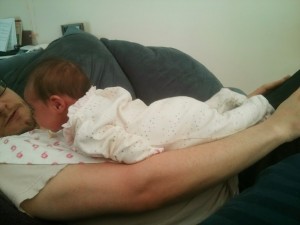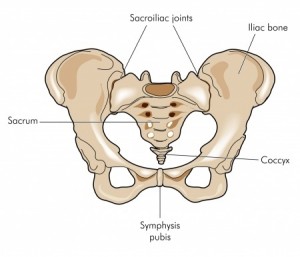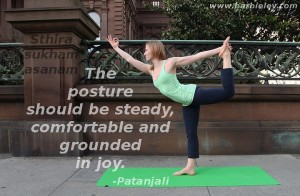Equinox Firestorm*
The usual narrative is usually that newborns are helpless. Growing up, I was repeatedly instructed, “Make sure to support her head!” whenever I was trusted to hold a baby. For the first three months they’re still supposed to essentially be fetuses; many people call them blobs. This was not my experience with Equinox Firestorm.
I don’t get ethereal often, so grant me this one paragraph. I’ve always found it a little woo woo when people say they’re “old souls,” but I’m going to say it about Equinox anyway: when she was born there was a wisdom, purposefulness, and fearlessness about her. As I’ve watched her develop from that newborn sage into a cute, pudgy three-month-old baby, it’s seemed as if she had to slowly forget her innate understanding of her place in the universe in order to learn how to smile, babble, and bat at her hanging toys. It’s like she’s doing the eight limbs of yoga backwards: letting go of samadhi (transcendence) so she can learn how to do asana (poses). Before she was born, I bought her a copy of, The Little Soul and The Sun, and this heartwarming children’s parable has come to my mind many times over the last twelve weeks. My hope for Equinox is that one day she will remember who she is; she is an ember with the potential to one day ignite a Firestorm.
During pregnancy, when the baby kicked strangers told me she would be a soccer player, but friends suspected she was actually doing rock-n-roll vinyasa in my belly. Turns out my friends were right: from our first days home she was already doing a perfect locust pose on Daddy’s tummy as he reclined back on the couch, and now she is weirdly comfortable resting in sphinx pose for several minutes at a time. I tried to lovingly support Equinox’s head when she was born, but she wouldn’t have any of it. Although her movements were uncoordinated at first, she’s always had control her head, and resists restraint. From day one, if she was hungry she would repeatedly thrust her gaping mouth against the chest of whomever was holding her making primal “gnar” sounds until she was lined up with a source of milk. All we could do was try to spot her. If I were to get a stick figure family for my Subaru, I’d get a mommy, a daddy, and a little tiny velociraptor.
Motherly Love
The big feelings of pregnancy have nothing on the big feelings of the postpartum period. I expected to feel warm, fuzzy motherly love the moment my little one was placed on my chest. But, as I mentioned in Equinox’s birth story, that moment was completely overwhelming for me. I don’t think I began to feel a soft, glowy, buttery type of love until six weeks when she started smiling at me; before that I felt an uncomfortable psycho-stalker infatuation type of love. One of the first of many sleeping arrangements Richard and I tried was to take two-hour shifts with the baby. I didn’t sleep during my shifts even though the baby did; I just stared at her, obsessively counting her breaths. Finally I bought a meticulously-researched mesh-walled co-sleeper that sat on the center of the bed, and was finally able to rest lying face-to-face with her.
To keep my epilepsy at bay, in Equinox’s fourth week, Richard began taking the her to the guest room all night long with a bottle of expressed milk on hand so I could get a solid seven hours of sleep. However, I had been feeding the baby on demand for a several weeks and our bodies were so in sync that, despite wearing earplugs and being on the opposite side of the house, I’d wake up at the same time as she did, literally (my breasts were engorged with milk) aching to be near her. Richard made me promise to stay in my bedroom and get some much-needed sleep. I was so drawn to the baby, that most nights it took every calming pranayama and yoga nidra practice I know to keep me in bed. Some nights it took half a tissue box worth of tears. And some nights none of that was enough: before the baby woke up, I’d tiptoe into the guestroom without waking Richard just to check on Equinox. If I was gazing at her with heart-melting motherly love this would have been sweet, but it wasn’t that; I was staring at her with compulsive, overly-obsessed mama bear love.
The weirdest thing that happened in that first month was that every time I woke up, I would think I was holding her nestled in my arms. My visual cortex would very clearly morph a fold in the quilt in my peripheral vision into the image of her face. If I didn’t know from studying Cognitive Science that peripheral vision is almost completely fabricated by the brain, I would have thought I was going nuts (most of the rest of the time she was in my arms, so my brain made a reasonable guess). For weeks, I lived out the first verse of You Are My Sunshine every time I woke up.
Thankfully, as the post-pregnancy hormones dissipated and I settled into motherhood the craziness subsided and was replaced by the type of love they portray in Similac commercials. Her smiles bring me endless joy, and I will do the most ridiculous goofball things to get a laugh out of her (she just laughed for the first time this week *melt*).
Mommy Tummy
I thought I would be at least a little upset about my mommy tummy, but I wasn’t. I had realistic expectations, so when I still looked six months pregnant after giving birth it didn’t phase me. For the first couple days postpartum, my belly felt weirdly empty and I felt bizarre shifts as my internal organs began returning to their rightful places. When I laughed, my belly jiggled like one of those jell-o cakes a neighbor would have brought to my door had I given birth in the fifties; the appearance and sensation made me want to laugh harder, but I had to resist for the sake of my stitches down below.
With the industry built around losing baby weight, I thought it would be much harder than it actually was. I gained thirty-seven pounds during pregnancy, which is slightly above the “ideal” range. A big chunk of that was just water, which I sweated, bled, peed, cried, and lactated out quickly. Without doing any exercise, within a few weeks of giving birth, I hovered at eight pounds above my pre-pregnancy weight (which I probably needed for breastfeeding), and by three months I was back down around my pre-pregnancy weight. I don’t have a celebrity-grade, airbrushed flat stomach or anything (I never have), but I really don’t feel like I have much extra fat to lose.
- Post-pregnancy body six days postpartum (This is the best postpartum belly photo I’ve got)
- Post-pregnancy body six weeks postpartum
- Post-pregnancy body six weeks from another angle. These were going to be “before” shots, but when I looked at them I realized I seemed perfectly healthy and didn’t need to change a thing.
That said, my abdominal muscles became weak and overstretched during pregnancy, so I started going to mommy and baby Pilates when Equinox was six weeks old. Also, my skin is a little worse for wear: I’m now sporting my fair share of stretch marks and the fading remnants of a linea nigra. During adolescence, I got stretch marks on my hips, thighs, and calves, so these new ones are just another addition to the collection, and I know from experience that they will fade. I think now I actually might be more likely to wear a bikini than I was before to make a body-positive statement that I shouldn’t have to hide my normal, healthy mommy tummy.
Postpartum Recovery
(This section may be TMI for some readers. Consider yourself warned, and skip it if you’d rather not know).
I’d always heard Cesarean births were tough to recover from, but I was not prepared for how long and frustrating the recovery from a vaginal birth would be. I think women don’t talk about this because chatting about the recovery process is unglamorous and low-priority; by the time we’re done telling postpartum guests about our unique birth story and about how our precious baby is doing it’s time for them to go home. I had no clue what I was in for.
Between the tear, catheter (I was too swollen to urinate after childbirth, and I needed another dose of fentanyl to stop sobbing, “No, please just let me try to pee on my own one more time! I can do it!” long enough for them to painfully insert a catheter), and painful varicosities (a common aftereffect of pushing), my “bottom,” as the nurses called it, was a disaster. My expectation was that it would kind of hurt to sit down for a couple days after birth, I’d bleed for a week or two, and then I’d feel all better. No. It took six weeks for the lochia (bleeding) to stop and to just be able to imagine that one day I might feel normal again down there. For the first day or two, my crotch was so sore that just getting up out of bed took several excruciating minutes and instead of walking around our hospital room, I shuffled around like an ancient mummy.
Sitting was surprisingly painful for the next two or three weeks, which made breastfeeding uncomfortable. Frustratingly, I couldn’t go from sitting to standing or vice versa while holding the baby, which made me feel helpless and dependent on others (although, why shouldn’t I have been? American culture has weirdly unrealistic expectations of new moms). What used to take two minutes in the bathroom took ten, and involved heavy-duty maxi pads, anesthetic spray, and a squeezable water bottle the hospital gave me to use a poor man’s bidet. They tell us that it’s safe for to have sex after six weeks, but for the record, “safe” doesn’t necessitate that one will be able to fathom attempting it so soon after pushing a human out of one’s body nor that it will feel good.
But, as we tell our postpartum guests if we do mention our discomfort at all, it was all worth it for my beautiful baby. And, as far as newborns go, I really do feel like I won the baby lottery. That’s not to say it’s been easy—we have all the typical newborn challenges (sometimes I can’t fathom baby care is just a normal, natural, no-big-deal thing humans have been doing since the dawn of our species), but that’s the thing: they’re typical. She’s the baby they write the books about. Harvey Karp’s Five S’s worked on her in the early weeks, she went through all the weird skin phases Baby 411 warned me about, and she hit her Wonder Weeks (i.e. the most non-wonderful weeks you can imagine) right on cue. She even speaks the Dunston Baby Language.
Postpartum Bliss
I’ve spoken with two camps of people: those who say, “Stay in the hospital for as long as they’ll let you and enjoy the ’round-the-clock care and free meals,” and those who say, “Get the hell out of that God-awful place as quickly as you can!” It turns out Richard and I fall into the latter camp. Although the midwives were wonderful and the lactation support I got was amazing, we couldn’t wait to escape being disrupted at least every two hours ’round the clock (especially since they inexplicably chose midnight as the ideal time to whisk the baby off to be weighed and measured); the cramped room alive with annoying indicator lights; and the suspiciously geometric food (although, admittedly Stoeffer’s and DiGiorno were staples in our diet for many weeks after the baby was born). Also, to protect their liability, the hospital staff was obligated to overreact to my epilepsy; At 3 a.m., one nurse took it upon herself to coerce me into interventions that I’d previously declined when I was too groggy to stand my ground. However, our first few days home were total bliss.
Throughout pregnancy I’d had debilitating hypermobility issues, but childbirth turned out to be the best chiropractic adjustment ever. I’d worked hard to build the strength to carry thirty-seven extra pounds on my hips, so my pelvic stability was better than ever when I instantly dropped a significant amount of that weight. During pregnancy, I was sure we’d bought a defective mattress for our new bed, but my first night home from the hospital I laid down sans the pile of pillows I’d needed to support my pregnant body, and it felt like I was sleeping on a wonderful, billowy cloud.
When I read stories about women who just loved being pregnant while I was waiting for Equinox, I rolled my eyes so hard because it wasn’t like that at all for me. This part of the story is going to be like that for parents with anything but the easiest of babies. If you had issues with breastfeeding or a sensitive baby (links to blogs by friends who dealt with these experiences), you may want to skip the rest of this section.
I have the type of good problems that they tell you not to confess to other parents: My breast milk fountains out so quickly and easily that it’s embarrassing to breastfeed in public: Equinox pulls off coughing loudly as milk jets uncontrollably all over her face (I did not know this was even possible). Needless to say, my clothes, sheets, furniture, and floors are all spattered with milk and my freezer is overflowing with full medela storage bags. I used to worry Equinox slept for too long of stretches, and I woke her up periodically to eat. I also used to think she was dangerously subdued (she nearly never cries inconsolably); I’ve accepted that she is just a good-natured, soothable baby.
A friend attributed her chill baby to having a chill pregnancy, and I took that to heart during my own pregnancy. So—sample size two—it’s worth taking those warm chamomile-lavender epsom salt baths if you are privileged enough to have the time and means.
My first few days at home with the baby were so joyful it was surreal. We could have been on the cover of a Hallmark card: we would take family naps with the baby in a cosleeper in the middle of the bed, and Richard and I spooning it on either side, our ankles intertwined with each other’s as if our bodies were forming a heart around the baby.
In the first week of breastfeeding, the hormones sent me into a state of euphoria. The day my milk came in, I felt like I was back on the fentanyl. Nowadays, I’ll catch up on the world news, apply filters to the daily baby photo I send to my mom, or even make a phone call while breastfeeding, but in those first couple weeks all of that just felt wrong. All I wanted to do was gaze down lovingly at the baby and marvel, Wow, she’s the most beautiful baby in the whole wide world.
Granted, the extreme highs were complemented by heavy lows. From about halfway through my first week to halfway through my third week postpartum, my “baby blues” (experienced by 70-80% of new moms) were like clockwork: I’d get inexplicably sad from about seven to nine in the evening, and cry over nothing, which was hard on both Richard and me, especially before we recognized what it was, that it was okay, and that it was temporary.
Postpartum Doula
A huge reason the first days went so smoothly was because we hired, Melitta Hoder, a postpartum doula. I cannot recommend her—and postpartum doulas in general—enough; she worked with me for nearly fifty hours over the first six weeks, and it cost less than what I paid my birth doula. She stopped by the hospital while we were there to make sure breastfeeding was going well, came over on our first night home to get us settled, and helped us get out the door with a packed diaper bag for our first pediatrician appointment (which neither Richard nor I would have even thought to bring at all). She taught me how to tie a Moby wrap, use my breast pump, and introduce a bottle without causing nipple confusion. She told me when to expect growth spurts so the all-night feeding frenzies didn’t come as a shock. When I worried about my milk supply (which I did constantly), she brought a scale to weigh Equinox before and after breastfeeding to find out exactly how much milk she was getting.
New parenthood is an incredibly sensitive, challenging, emotional time, and postpartum doulas are trained (and in Melitta’s case, experienced) in supporting this transition. My mom and sister graciously calmed the baby when she was fussy while they were in town during Equinox’s third week (not to mention that they concocted homemade granola bars and cleaned my toilets), but most visitors will thrust a baby back into his or her parents’ arms in horror the moment he or she begins to cry. Melitta let me feed the baby and have some precious bonding time with her while she was contented, then took her when she needed to be burped, soothed, or changed and urged me to go take a nap. When I woke up, the dishes had been washed, the laundry had been done, and there was a plate of apples, almond butter, boiled eggs, oatmeal cookies and cheese for me to snack on next to my breastfeeding spot. I began watching Melitta carefully to learn how she managed to care for the baby and do all of that at the same time.
Melitta was compassionate and supportive of me being where I was in my process of learning how to be a parent, but she gently and constantly lead me toward the next step. For example, while I ate lunch she would talk to the Equinox, saying, “I’m going to hold you for a bit so Mommy can eat lunch. One day, Mommy will learn to breastfeed with one hand, and you’ll both be able to eat at the same time!” I hadn’t been around enough breastfeeding mothers to know this was the next step.
Then Things Got Hard…
One of the things Melitta repeatedly warned me about was that babies get progressively fussier until six to eight weeks, and then they plateau (and maybe get better). It took at least eight weeks. Because I have what I would still consider to be an easy baby, I can say with some authority that when parents of older children tell you, “Cherish this time, you’re going to miss it,” they either think your newborn baby is a joyful, curious three-month-old who smiles and plays or they completely repressed the newborn stage. Once the initial bliss and novelty wore off for us, shit got real.
Although Equinox slept well (a couple four-hour stretches at night), we didn’t. When she was a newborn she had a repertoire of sleep sounds from humming to croaking, which made it nearly impossible to sleep in the same room as her. Then, when she had the odd segment of quiet sleep I compulsively checked her to make sure she hadn’t suffocated. Richard was less paranoid, but he started developing nervous tics from listening to the obnoxiously loud white noise the baby needed to sleep all night long. Every few nights we changed sleeping arrangements, trying to find a configuration in which everyone could sleep. There wasn’t one.
When Equinox was about a month old, she went through a phase in which she would only sleep while we were walking her around in the baby carrier. I don’t know what we would have done without Melitta coming by with knowledge and energy (which we definitely lacked after a few days of this) to teach us how to get her to nap in our Rock N’ Play (a rocking bassinet).
When Richard was heading back to work and Equinox was an alert and awake one-month-old (meaning less nap time for me when sleep deprivation is my main seizure trigger), I listened to some early signals from my body and begrudgingly went on epilepsy medication. I cried the last time I breastfed the baby without traces of the drugs in my milk (even though my doctors and lactation consultant say there’s no evidence that what I’m taking is hazardous to her). I was meticulous about prenatal nutrition, and choose to believe that made her resilient enough to handle a little bit of medicine. Going on medication was heart-wrenching at the time, but it’s improved the quality of my life and relationship with the baby so much that I have let go of much of the guilt I initially felt. Before I was on the medication, I needed the baby to sleep at certain times so I could catch up on my own sleep, and looking back over the commitments I made to my daughter reminded that this was not who I wanted to be as a mother. Months ago, I wrote:
I hold onto no disillusion that I possess you, control you, or am entitled to anything from you.
It feels good to not need anything from my little one.
I still exclusively breastfeed Equinox, and hope to continue breastfeeding her for as long as there are proven benefits. Breast milk advocates will tell you that it is a beautiful, amazing bonding experience with the baby—and it is. It is also one of the most isolating things I’ve ever done. Once the initial novelty and gaga hormones wore off, I realized I was spending a third of my day in a dimly-lit nursery with no other adults to talk to, my only company a tiny human leaching nutrients out of my body. When I started breastfeeding in public, many people avoided looking at me. I was eager to introduce bottle feeding so Richard could give me a break, but for every bottle I have to go back to my lonely glider chair and have a robot leach nutrients from my body (side note: I laughed out loud the first time I used my breast pump. It is so weird).
I am thankful I found the New Moms’ Support Group at Natural Resources in San Francisco around five weeks postpartum. Nursing alongside other mamas brought a social element and a sense of solidarity to the experience. Having a supportive community where I could vent without judgement and be reassured that it would get easier as the baby developed was relieving and helped me recharge. (Sure enough, breastfeeding sessions are now a third as long as they used to be).
A friend of mine had a baby after she’d been with her partner for ten years, and she reported that it hadn’t shaken their relationship because after all those years together they were totally in sync. Richard and I have been together for seven years, and I thought we’d be the same. Nope. Babies are warm, soft, squishy wedges that drive themselves between partners, and we had some pretty brutal fights in the first six weeks. Long before I got pregnant I read Misadventures of a Parenting Yogi by Brian Leaf, and a quote from him came back to me many times in the early days:
I don’t think couples with small children should be allowed to divorce. With no time to connect, lacking sleep, and always feeling overwhelmed parents of very small children, it seems to me, are not of sound mind to make such a life-changing decision.
Things never got that bad, but reflecting on this quote helped me keep the experience we had in perspective. As time went on, the intensity of our arguments dropped off as we relearned how to communicate and were able to spend more alone time together as Equinox’s sleep patterns became more predictable.
…Then Things Got So Much Better
For the first eight weeks I was in survival mode, and I had to really try to be present and cherish the joyful moments. At three months now, we’ve hit a sweet spot in which Equinox constantly draws me into presence, so many moments are unforgettable, and time is starting to move too quickly. Although she has her occasional regressions that have me up every hour all night, her sleep is becoming more manageable and predictable. Every morning when she opens her eyes and sees my face, she breaks into big gummy smile. When I play with her she discovers exciting new skills she integrated overnight. Sometimes she’s energetic and will let out guttural laugh when the dog licks her face. Sometimes she’s mellow and wants nothing more than to cuddle up with me all afternoon, nursing and sleeping.
My biggest challenge lately is giving her the space to explore her independence. For example, she is now learning to soothe herself to sleep, and it takes all my effort to resist swooping in at the first sign of fussiness. I thought empowering her would be my forte, but it is surprisingly hard for me. Lately I’ve found myself drawing strength from one of the commitments I made to her before she was born:
I give you enough structure for you to develop security and trust, and enough freedom to explore, express your creativity, and make your own mistakes. I allow this balance to shift as you grow and develop.
It was worth it to write these commitments down before I moved into the alternate dimension of motherhood.
Equinox is not a newborn any more, and it’s exciting, and overwhelming, and amazing, and terrifying all at the same time. Every day requires me to take another step farther outside my comfort zone, and every day I manage to meet that challenge. All the techniques I learned for childbirth (cleansing breaths, letting go of control, trusting my instincts, integrating with my partner, etc.) have turned out to apply even more to parenthood than it did to the birthing process. I’ve only practiced yoga in a studio once since I gave birth, but somehow I don’t feel like I’m missing out. I’m still practicing the eight limbs of yoga on a daily (or hourly, or minutely) basis but in a different form. If yoga class is the “practice,” then motherhood is the real thing.
*Name changed.







